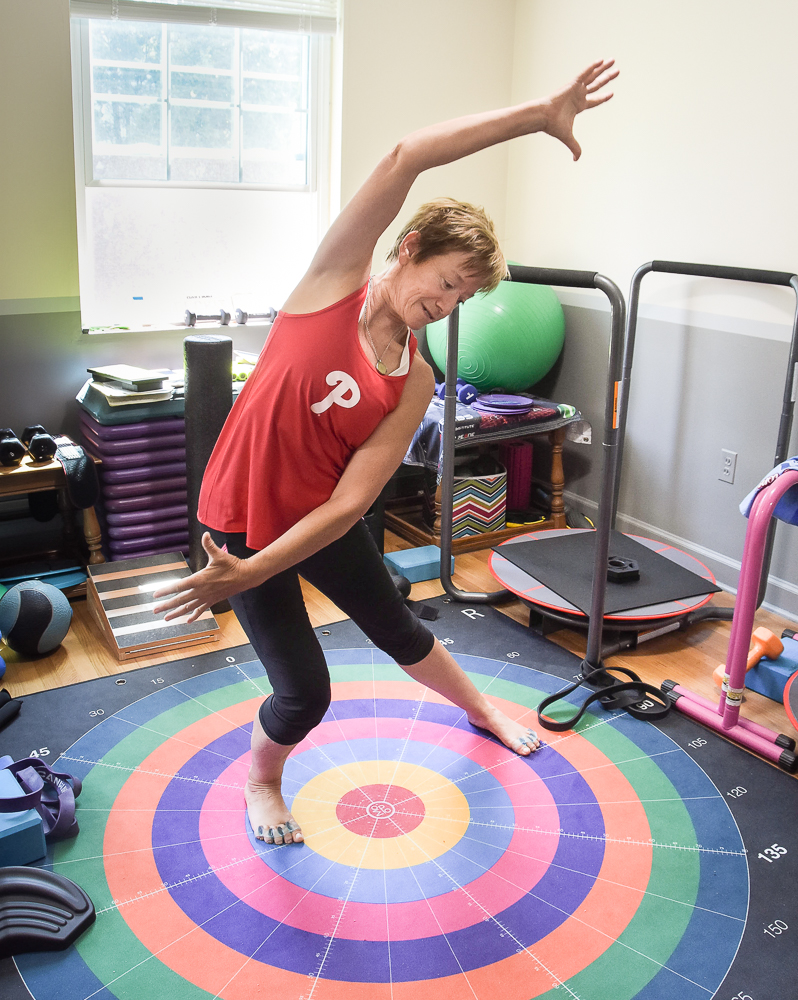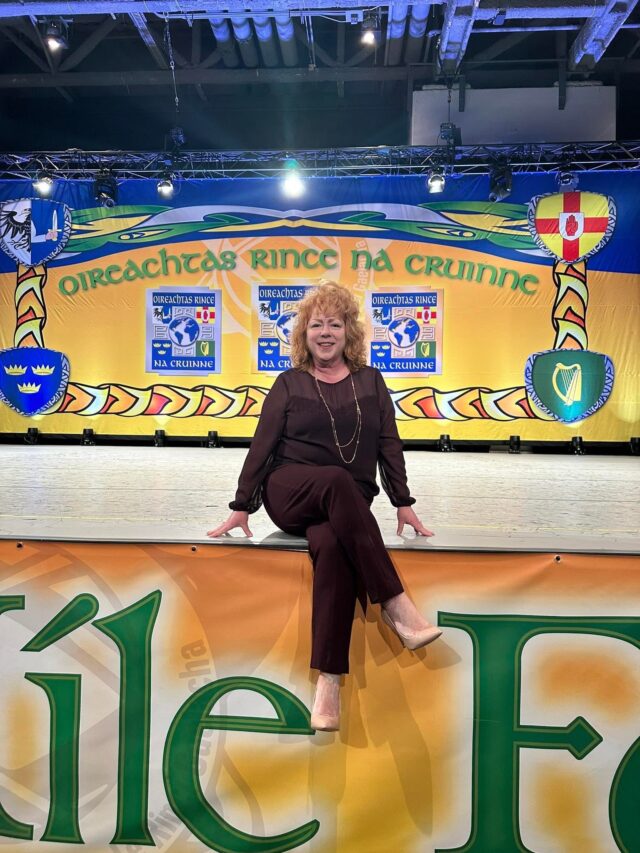If you want to know the secret behind some winning Irish dancers, the Proud Mama Facebook posts say it all.
From one whose daughter placed second in the under 22 age group at the regional Irish dance competition knowns as Oireachtas: “Thank you Angela for getting Chloe into dance shape both mentally and physically.”
From another, whose daughter placed third in her competition and qualified for the world championships: “Thank you to all who have continued to believe in her and support her,” singling out “her personal trainer, Angela Mohan.”
And another, posting a photo of her beaming daughter, medal in hand, with an equally beaming Angela Mohan, “Love you Angela Mohan. . .You have taught Mairin. . .lifelong lessons of health, mental toughness and perserverence.”
When Angela Mohan left Bantry, County Tyrone in 1981 to come to America, she had no idea that one day she would become the go-to personal movement coach for Irish dancers both around the country and around the world. The only thing the Broomall resident had in her mind was to make a living and play camogie—the female version of the stick-and-ball game of hurling—which she played at home and for many years with the Philadelphia Gaelic Athletic Association (GAA).
With a friend, she started her own successful cleaning business and co-founded the first ladies Gaelic football club (GFC) in Philadelphia—the Emerald Eagles—and its successor, the Mairead Farrell GFC for which she served as both player and coach.
A physical fitness buff, she opened her own personal training business about 2000, offering classes and personal training to individuals, and by 2012 a number of her clients were Irish dancers looking for an edge in the competitive world of Irish dancing.
By 2016, however, her own health problems and a serendipitous introduction to a new concept in personal training turned her into Angela Mohan, functional movement specialist, with clientele both in the US, Ireland, and the UK.
And, if you believe one of the Irish dancers she’s worked with, she’s “the witch doctor” of step dancers.
“That’s what my 12-year-old daughter Mairead affectionately called her after she worked with her on weaknesses in her feet and ankles,” says Katie Raley of Kennett Square, who is not only a dance mom but a dance instructor at McGough Academy at its West Chester location. “Angela is really good at what she does. She knows how the muscles and joints work, why dancers have irritations in certain areas and why their movements aren’t as good as they should be. Mairead called her a ‘witch doctor’ because she said she’s one of those people, you don’t know what she did to you, but all of a sudden, she’s fixed you.”
Raley recalls bringing Angela to work with an entire class “and she looked at group and said, ‘Everybody’s posture is awful!’” She laughed. “She literally had us stand against the wall—me too—with our heels, shoulders, and head touching the wall. All of a sudden, we were in perfect alignment. We could feel it. It’s so simple and easy, but wow!”
One of the many “wow” but simple techniques Mohan uses with the young dancers is to manipulate their toes which, when they’re not crunched into hard shoes are bearing the brunt of the landing from a leap that exerts the force of “four to nine times their body weight,” she says.
Most of her dancers also wear flexible toe separators that keep the toes apart. After a lifetime of being squished into narrow shoes, the toes can bend inward and the connective tissue between them shorten, restricting blood flow, depriving the tissue and nerves of oxygen, and ultimately creating painful, disfiguring bunions. The separators can help with stability, balance, and even strengthen foot muscles.
“It’s all bang, bang, stomp, stomp, and eventually their toes get stuck. They can’t move. I move the toes up and down, around, then the foot up and down, forward and back, and tell them to go for a wee walk,” she says. “ When I ask ‘How do you feel’ I ask they usually say ‘bouncy,’ ‘I can jump higher,’ ‘I feel light.’ Some just say, ‘I don’t know how to explain it but it feels good.’”
Mohan’s techniques come from the most up-to-date playbook of modern science: that of 3-D conditioning. It’s been endorsed by the National Federation of Professional Trainers.
The human body, she points out, is meant to move in all directions: up, down, forward, backward, side to side, and rotationally. Those are known as the “planes of motion.” Muscles and bones may go through all of them in just one movement. Traditional athletic training—and make no mistake, Irish dancers are athletes—focuses strictly on the planes of motion that the sport or activity demands, creating strength in some areas and weakness in others. That imbalance leads to injury.
“One of the reasons I wanted to work with Angela is that I grew up dancing so I have a pretty pronounced bunion on one foot from dancing incorrectly for years,” says Raley.
Mohan’s 3D exercises may seem familiar at first, but she takes them in a direction that looks more like interpretive dance. Participants in the 3D functional yoga class she’s running for Marple Newtown Recreation (April 25-May 10) will be starting with ordinary yoga poses but with twists and turns that involve the whole body. The Warrior pose, for example, isn’t simply “knee bent, hips thrust forward, arms over the head.” The torso may twist, the arms move forward and back, and the hips thrust backward in whatever range of motion the body is capable of, then return to the traditional pose.
Mohan studied 3D movement at the Gray Institute in Michigan, founded by a physical therapist, where she earned her certificate in Applied Functional Science in 2016. That led her to the functional medicine physicians and experts who helped her on her own health journey. Though physically fit, Mohan has struggled most of her life with sore joints, painful hips, a weakness on one side of her body, digestive and skin issues. “I was broken,” she says. “I wanted to find a way to get healthy.”
Functional medicine doctors—there are several in the Main Line Health Network—are like the holistic doctors of the past. They’re trained to look at a patient’s entire body and life, not just the one thing that hurts, to try to find the source of their condition. They explore a patient’s stressors, sleep patterns, nutrition, exercise, traumas, recognizing that emotional and environmental issues can affect an individual’s health and even what genes come into play. They use both traditional and alternative treatments—from medicine to meditation—to restore patients to health.
From the experts, she learned about inflammation, lymphatic massage, immunity, and the power of diaphragmatic breathing which can reduce chronic hyperventilation—often a symptom of physiological stress.
Massage, breathing exercises, making lifestyle changes that lower damaging inflammation in her body has helped Mohan feel the best she’s felt in her 62 years, and she shares what she’s learned with her clients.
Those toe exercises? Early on in her treatment, her doctor shocked her when he asked her to get onto the floor and sit back on her feet. When she did, he showed her that both sides of her body weren’t balanced on her feet. “It blew my mind,” she says. “One of my toes was turned in and it was throwing my hip and my shoulder off.”
Today, after years of wearing toe separators and manipulating her feet, her body is balanced when she repeats the exercise—and she’s not in any pain.
Her dancers aren’t always eager to walk around in toe separators—that is, until they do and start feeling better.
The dancers have also been reluctant to wear the Myotape mouth tape—a rectangle of tape with an opening for the mouth–that she recommends. The product, which is marketed to prevent snoring, promote sleep, reduce anxiety and boost athletic performance, creates a light elastic tension that, over time, trains the wearer to keep the lips closed and encourages nasal breathing which tends to be deeper than mouth breathing.
Then, the kids try it and start feeling better.
“The kids all say, ‘Oh my gosh why I am doing this?’” says Katie Raley, laughing. “But in the end it slows down your breathing when you’re dancing, it makes you focus more on taking deep breaths, rather than short shallow breath that won’t help you dance well.”
The proof is always in the results, and Mohan gets results. Using all the techniques she amassed since 2016, she’s coached several dancers, including her 15-year-old niece Blaithin Mohan, to World Championships (Blaithin was the youngest ever world champion).
“One of the things she’s especially good at is getting kids to calm down,” says Raley. “Using her breathing and other techniques, she takes them out of that tense competitive environment and helps them focus and relax before sending them out to compete. We’ve had to rush kids over to her who have major issues, even one who won a World championship last year. She almost didn’t make it through the competition. It was only because of Angela that she was able to.”



